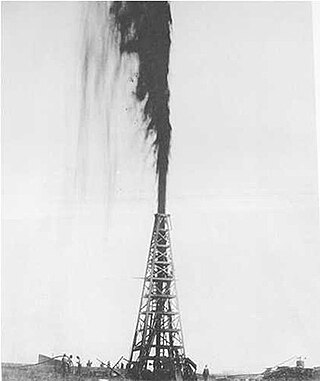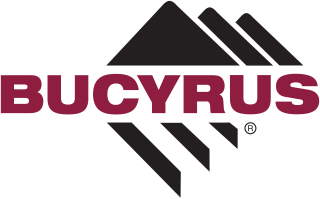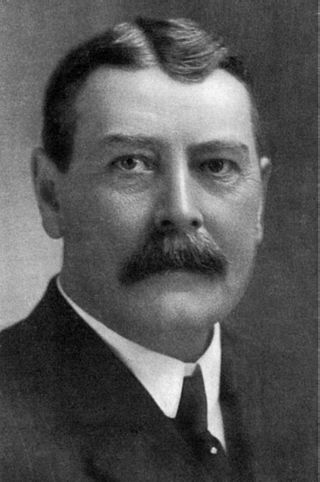
Underground hard-rock mining refers to various underground mining techniques used to excavate "hard" minerals, usually those containing metals, such as ore containing gold, silver, iron, copper, zinc, nickel, tin, and lead. It also involves the same techniques used to excavate ores of gems, such as diamonds and rubies. Soft-rock mining refers to the excavation of softer minerals, such as salt, coal, and oil sands.

Nuiqsut is a city in North Slope Borough, Alaska, United States. The population was 512 at the 2020 Census and 92.5% Alaska Native. It is located in the midst of a vast quantity of oil reserves and the closest community to ConocoPhillips oil drilling project named Willow Project in the Alpine, Alaska oil field of the National Petroleum Reserve–Alaska. It owns the surface rights, but not the subsurface rights of the Alpine field, which are with the regional Arctic Slope Regional Corporation.

Ocean Ranger was a semi-submersible mobile offshore drilling unit that sank in Canadian waters on 15 February 1982. It was drilling an exploration well on the Grand Banks of Newfoundland, 267 kilometres (166 mi) east of St. John's, Newfoundland, for Mobil Oil of Canada, Ltd. (MOCAN) with 84 crew members on board when it sank. There were no survivors.
This article lists extreme locations on Earth that hold geographical records or are otherwise known for their geophysical or meteorological superlatives. All of these locations are Earth-wide extremes; extremes of individual continents or countries are not listed.

The petroleum industry, also known as the oil industry, includes the global processes of exploration, extraction, refining, transportation, and marketing of petroleum products. The largest volume products of the industry are fuel oil and gasoline (petrol). Petroleum is also the raw material for many chemical products, including pharmaceuticals, solvents, fertilizers, pesticides, synthetic fragrances, and plastics. The industry is usually divided into three major components: upstream, midstream, and downstream. Upstream regards exploration and extraction of crude oil, midstream encompasses transportation and storage of crude, and downstream concerns refining crude oil into various end products.

Directional drilling is the practice of drilling non-vertical bores. It can be broken down into four main groups: oilfield directional drilling, utility installation directional drilling, directional boring, and surface in seam (SIS), which horizontally intersects a vertical bore target to extract coal bed methane.

Project Rulison, named after the rural community of Rulison, Colorado, was an underground 40-kiloton nuclear test project in the United States on September 10, 1969, about 8 miles (13 km) SE of the town of Grand Valley, Colorado in Garfield County. The location of "Surface Ground Zero" is 39°24′19.0″N107°56′54.7″W. The depth of the test cavity was approximately 8,400 ft (2,600 m) below the ground surface. It was part of the Operation Mandrel weapons test series under the name Mandrel Rulison, as well as the Operation Plowshare project which explored peaceful engineering uses of nuclear explosions. The peaceful aim of Project Rulison was to determine if natural gas could be easily liberated from underground regions. This site remains under active monitoring by the U.S. Department of Energy Office of Legacy Management.
The oil and gas industry is usually divided into three major sectors: upstream, midstream and downstream. The upstream sector includes searching for potential underground or underwater crude oil and natural gas fields, drilling exploratory wells, and subsequently operating the wells that recover and bring the crude oil or raw natural gas to the surface.
Underground coal gasification (UCG) is an industrial process which converts coal into product gas. UCG is an in-situ gasification process, carried out in non-mined coal seams using injection of oxidants and steam. The product gas is brought to the surface through production wells drilled from the surface.

A blowout is the uncontrolled release of crude oil and/or natural gas from an oil well or gas well after pressure control systems have failed. Modern wells have blowout preventers intended to prevent such an occurrence. An accidental spark during a blowout can lead to a catastrophic oil or gas fire.

Bucyrus-Erie was an American surface and underground mining equipment company. It was founded as Bucyrus Foundry and Manufacturing Company in Bucyrus, Ohio, in 1880. Bucyrus moved its headquarters to South Milwaukee, Wisconsin, in 1893. In 1927, Bucyrus merged with the Erie Steam Shovel Company to form Bucyrus-Erie. In 1997, it was renamed Bucyrus International, Inc. In 2010 the enterprise was purchased by Caterpillar in a US$7.6 billion transaction that closed on July 8, 2011. At the time of its acquisition, the Bucyrus product line included a range of material removal and material handling products used in both surface and underground mining.

The Sidoarjo mud flow is the result of an erupting mud volcano in the subdistrict of Porong, Sidoarjo in East Java, Indonesia that has been in eruption since May 2006. It is the biggest mud volcano in the world; responsibility for the disaster was assigned to the blowout of a natural gas well drilled by PT Lapindo Brantas, although company officials contend it was caused by a very distant earthquake that occurred in a different province.

Directional boring, also referred to as horizontal directional drilling (HDD), is a minimal impact trenchless method of installing underground utilities such as pipe, conduit, or cables in a relatively shallow arc or radius along a prescribed underground path using a surface-launched drilling rig. Directional boring offers significant environmental advantages over traditional cut and cover pipeline/utility installations. The technique is routinely used when conventional trenching or excavating is not practical or when minimal surface disturbance is required.

Petroleum is a fossil fuel that can be drawn from beneath the Earth's surface. Reservoirs of petroleum are formed through the mixture of plants, algae, and sediments in shallow seas under high pressure. Petroleum is mostly recovered from oil drilling. Seismic surveys and other methods are used to locate oil reservoirs. Oil rigs and oil platforms are used to drill long holes into the earth to create an oil well and extract petroleum. After extraction, oil is refined to make gasoline and other products such as tires and refrigerators. Extraction of petroleum can be dangerous and have led to oil spills.

A well is an excavation or structure created on the earth by digging, driving, or drilling to access liquid resources, usually water. The oldest and most common kind of well is a water well, to access groundwater in underground aquifers. The well water is drawn up by a pump, or using containers, such as buckets that are raised mechanically or by hand. Water can also be injected back into the aquifer through the well. Wells were first constructed at least eight thousand years ago and historically vary in construction from a sediment of a dry watercourse to the qanats of Iran, and the stepwells and sakiehs of India. Placing a lining in the well shaft helps create stability, and linings of wood or wickerwork date back at least as far as the Iron Age.
The Saint Lawrence River HVDC Powerline Crossing is the crossing of Hydro-Québec's Quebec-New England HVDC transmission line over the Saint Lawrence River between Grondines and Lotbinière, Quebec, Canada. The crossing is remarkable, for being first implemented as an overhead crossing, and then later replaced by a cable tunnel. Hydro-Québec wanted to complete the transmission line in time, which was only possible with an overhead crossing of Saint Lawrence River. However, due to the negative visual impact of the large towers of the overhead crossing on the local populations of Grondines and Lotbinière, it was decided to build a cable tunnel under the river, although this made the project more expensive.

Joy Global Inc. was a company that manufactured and serviced heavy equipment used in the extraction and haulage of coal and minerals in both underground and surface mining. The company had manufacturing facilities in Alabama, Pennsylvania, Texas, Wisconsin, Australia, Canada, China, France, South Africa, Poland and the United Kingdom. In 2017, Joy Global was acquired by Komatsu Limited and was renamed Komatsu Mining Corp.

Murray & Roberts Holdings Ltd. is a South African-based engineering and mining contractor. It is listed on the JSE Securities Exchange. The Group delivers its capabilities into three global primary market sectors the resources, industrial, energy, water and specialised infrastructure market sectors.
Jackson Prairie Underground Natural Gas Storage Facility is a natural gas storage facility in Southwest Washington. The site is owned by Puget Sound Energy, Avista and Williams Companies's Northwest Pipeline GP. With 25 billion cubic feet working capacity, it is the largest natural gas-storage reservoir in the Pacific Northwest and the 14th largest in the United States.














